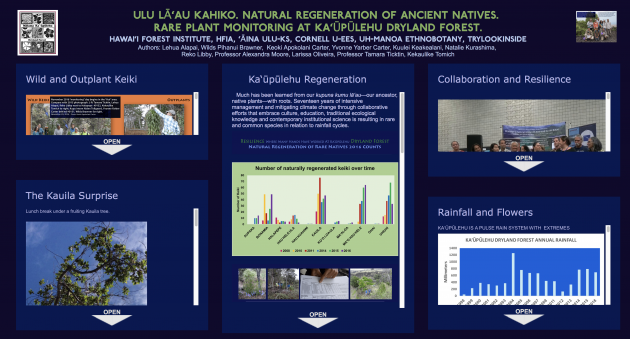A beloved native forest.
2020 Introduction and virtual visit to the forest the year of Covid. And 2017, learning from place and the forest hui.
Still, the forest flourishes and native birdsong rings sweetly through the forest.
So does the cackling of non-natives.
———
Learning from place 2017. Meet some plants cared for by site manager Wilds and the Ka‘ūpūlehu hui.
Mahalo to haumana of kaiapuni ʻo Waiau visiting from Oahu for bringing joy
and olelo to the forest.
Aloha to their teachers and Hawai’i island grown kumu Iwalani Benton Foster.
———
Wai o Kane. An enduring naming story of Ka‘ūpūlehu. Connecting to place.
Ku’ulei Keakealani shares a mo‘olelo (story) of these homelands.
It is one of several naming stories and teaches us much of place and possibilities,
much as it did for her as a child and her long line of ancestors before her.
Welcome to the time of Kumukeakalani at Kahuwai.
—————
Forest Never Forgets
Anakala Keoki shares briefly why he has just asked haumana (students) to voice their names to this ancient forest where many have walked before.
———
Another Virtual Visit—Meet A Few Of The Natives
———
Ka‘ūpūlehu Dryland Forest Learning Resource (2000′ level also see Kalaemano shoreline brochure)
———
Ku’ulei Keakealani Sharing at Kaūpūlehu Forest
Ka Pilina ‘Ole—(Un-severed Relationships)
———
Aloha Āina restoration program at Ho‘ola Ka Makana‘ā
An amazing photo glimpse of place.
Ho‘ola Ka Makana‘ā—a land-based education program—is a collaborative cultural ecology, outreach, and stewardship project at the Ka‘ūpūlehu dryland forest on the lee of Hualālai mountain.
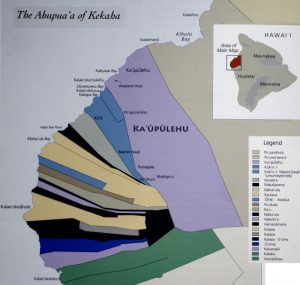
Map adapted from the book ” In the Lee of Hualālai”
This 70-acre preserve, located in the mauka area of the Ahupua’a of Ka‘ūpūlehu, was originally fenced, tended and managed by the Dryland Forest Working Group in the late 1990s with HFIA (Hawai`i Forest Industry Association), as a demonstration and science research project to protect rare native plants and learn more about these disappearing ecosystems. That early vital work has evolved into a collaboration mauka-makai, with discerning stewardship learning opportunities for a wide range of groups and individuals including: youth, high school, graduate students, community, lineal descendants cultural practitioners, educators and scientists.
The program name means “Healing the Place Budding Up Out of the Lava” and represents the hard place of raising awareness and restoring a severely impacted ecosystem. At the same time it also recognizes the “hard place” our communities face being able to connect to special legacy lands and places that rejuvenate the spirit.
———
In these rare and special lands, both native seeds and seeds of hope are planted and flourish with the continued efforts of many, as described in the following video:
Missing from the above video due to travel is another treasured staff member and “culture keeper” as well as site manager, Wilds Pihanui Brawner. Mahalo nui to the OHA multi-media team and editor for this work, and for the ‘Āina grant to support this effort and multi-media journey.
Ho‘ola Ka Makana‘ā is an `Aina Ulu land-based bio-cultural education project of Kamehameha Schools. Since the the ‘Āina Ulu component began in 2002 under the direction of Yvonne Yarber Carter over 7,700 volunteers (thru 2016) have given something of themselves to revitalizing this special dryland forest through outplanting, weeding, and trailbuilding. Science partners provide important collaborative management and educational facets to ecosystem resilience and monitoring. Since 2002 the program and staff has expanded as described below and the next generation of stewards have joined the collective kuleana to grow together with the forest. Wilds Pihanui Brawner became the Site Manager in 2008, heading up the restoration strand. Ku‘ulei Keakealani strengthens mauka-makai connections; tending to and sharing ‘ike kupuna—historical and ancestral knowledge. “Uncle” Keoki Apokolani Carter directs the Mea Lāʻau component and provides multi-generational guidance and training. Lehua Alapai took on the role of Outreach Coordinator in 2017 as programs expanded and Yvonneʻs work shifted to coordinating the programs, resource development, multimedia and grant support. HFIA is the fiscal manager of the programs with the valued support of Heather Simmons, Executive Director of the non-profits HFI and HFIA.
Information about the four programs that work together can be found below, including the vision and mission statements used as a guiding light.
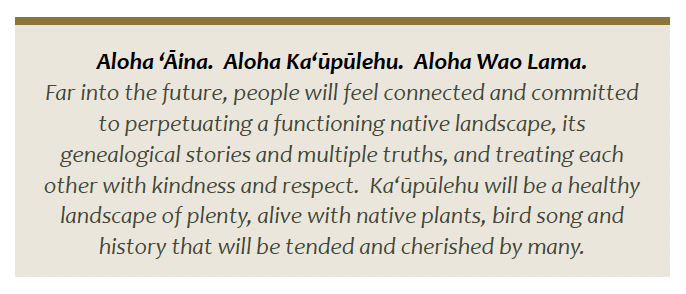
Vision Statement
The collective mission statement explains further:
E ola ka mālamalama o Ka‘ūpūlehu. Life to the radiancy of Ka‘ūpūlehu (Kaulupūlehu). Our mission is to tend, honor, and grow a place of peace and safety for the dryland lama forest community of Ka‘ūpūlehu. We strive to carry the “torch” and “light” and promote the rigorous learning that the name “lama” suggests.
Relationship Chart
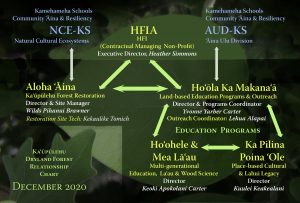
The four integrated programs provide a dynamic program that collaborates with efforts within the ahupua‘a and beyond.
The programs with their support staff are:
- Ho‘ola Ka Makana‘ā, programs integration, ‘Āina Ulu education, partners, and outreach component.
Director, Yvonne Yarber Carter; Outreach Coordinator, Lehua Alapai - Aloha ‘Āina—Aloha Ka‘ūpūlehu, restoration and site management.
Site Manager, Wilds Pihanui Brawner; Site technician, Kekaulike Tomich - Ka Pilina Poina ‘Ole, TEK, homeland connections, mo‘olelo, Kekaha ahupua‘a and mauka-makai education.
Director, Kuulei Keakealani - Mea Lā‘au, wood science, cultural foundations, hands-on resources, all things la‘au and sounds from the forest.
Director, Keoki Apokolani Carter
———-
Makai education brochure-Kalaemano
Ike Kūpuna – Hualālai Connections
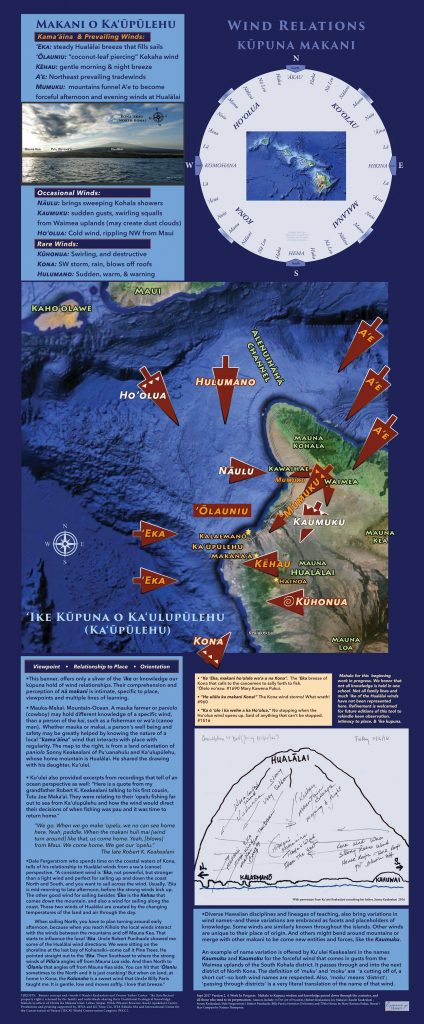
One of their learning resources pictured on the right: Makani O Ka‘ūpūlehu is a collaborative effort with kūpuna (respected elders) of the region on the West slopes of Hualālai on Hawai‘i Island. It is the region known as Kekaha. This graphic on the makani (winds) of the region is a work in progress with its central reference point being mauka and makai in the lands of Kekaha (see the map above to see the region’s ahupua‘a). The authors honor multiple viewpoints and knowledge held about the winds—recognizing that they have only skimmed the surface here. Learn more here: Makani O Ka‘ūpūlehu
For those who visit the forest, Ka‘ūpūlehu does have a protocol of entry that might be different from others, as place calls for different relationships:
“Preparing for entry at the beginning of a site visit is a protocol reflecting the spirit and dynamic energy that impacts thought, intent and actions. It sets the foundation for how we come together to build kinship ties to our elder trees and landscape. Ka‘ulupūlehu also Ka‘ūpūlehu is not only a rare and threatened tropical dryland ecosystem, it is a beloved community of ‘Āina Kupuna (elder rocks, trees, soil, air, wind, plants and other living things) that a growing number of people tend and cherish and counsel for guidance. Often, people of these lands feel the necessity to give proper cultural respect by acknowledging they are entering another domain as a guest of beloved forest elders and cousins, and asking permission in order to prepare to meet the energy of place. Because the volunteer efforts here are sometimes multi-cultural and multi-ethnic, we have instituted a simple inclusive protocol that honors the Hawaiian lineage of these lands while respecting the broad range of beliefs that may be represented by others. It is called ho`omalie, where we simply come together before entering the gate in silence. It is a time when we quiet our selves and focus on the work ahead. A time to leave our individual rubbish and worries outside so we can be open to whatever the forest has to offer. And to remember we are here to offer ourselves in the most positive spirit of respect for a hopeful future. When we are lucky enough to have the presence of a descendant of these lands, or a group to oli, these are given after ho`omalie, but not expected. The circle then continues in silence to take note of the response given by place—sometimes through the changing breezes, bird song, cloud cover, silence or sunlight. This practice of Ho‘omālie /Ho‘omalu was taught to Keoki & Yvonne Carter, the outreach education program founders, by their lā‘au lapa‘au po‘okela, Papa Henry Auwae. He explained that collective participation would promote mutual safety, and respect between each other and place. And with time and deep commitment, bring lokahi. He said, “Lokahi is essential. Lokahi is harmony of body, mind & spirit with oneself, others and nature.”
More Resources
Enjoy one of many mo‘olelo and poems shared by Ku‘ulei Keakealani, director of Ka Pilina Poina ‘Ole. The following video is Ku‘ulei giving a keynote address at the 2016 Nāhelehele Dryland Symposium: “Wiliwili My Relations”
The following two 2018 presentations at the Nahelehele Dryland Symposium discuss collaborative work in monitoring natural regeneration of rare natives at Ka‘ūpūlehu:
The following link provides videos of presentations by the Ka‘ūpūlehu extended ‘Ohana at the 2016 IUCN World Conservation Conference: VIDEO LINK
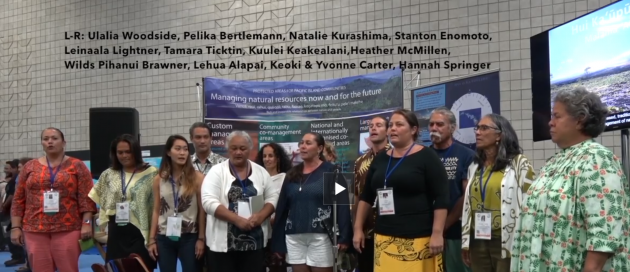
Ka‘ūpūlehu extended ‘Ohana at the 2016 IUCN World Conservation Conference
At the 2017 HCC Hawai‘i Conservation Conference, Ka‘ūpūlehu submitted an e-poster about monitoring collaboration titled “Ulu Lā‘au Kahiko. Natural Regeneration of Ancient Natives”. This e-brochure documents the positive results from efforts to mitigate climate change through increasing canopy and ground cover shade by planting natives. Mahalo to support from IUCN (International Union for the Conservation of Nature) and WCC (World Climate Change Fund) which made this electronic multi-media brochure and its presentation at HCC a possibility. This format allows Ka‘ūpūlehu to reach many more people and reduce its carbon footprint.
Another important Ka‘ūpūlehu collaboration has been with the PICCC (Pacific Islands Climate Change Cooperative) project. This diverse, extended ‘ohana created a seasonal calendar and educational portal as one of the PICCC TEK (Traditional Education Knowledge) sites. The following links will connect you to a few of the many resources used to better understand, plan and manage the lands of Ka‘ūpūlehu.
Ka‘ūpūlehu Weather Station: http://hbmpweb.pbrc.hawaii.edu/kaupulehu/weather
Fire History and Fire Threat Index: http://hbmpweb.pbrc.hawaii.edu/kaupulehu/fire
Timeline of Adaptation: http://hbmpweb.pbrc.hawaii.edu/kaupulehu/timeline
Native Plant Distribution predictions for 2100 impacted by climate change: http://hbmpweb.pbrc.hawaii.edu/kaupulehu/plant_distributions
Dynamic Seasonal Calendar: http://hbmpweb.pbrc.hawaii.edu/kaupulehu/seasonal%20calendar
———-
A Song Composed for Ka‘ūpūlehu
Many are inspired by the lands of Ka‘ūpūlehu. One example is Lihau Hannahs Paik who interned at the forest in 2003. In 2012, Lihau and husband Kellen Paik composed a beautiful tribute to these lands for the Kamehameha Schools Song Contest. The preshow program featured several sites with mālama ‘āina programs, including Ka‘ūpūlehu and several other ‘Āina Ulu outdoor learning sites including Waipā, and Heeia fishpond. That show can be viewed below. Eighteen minutes into the video begins a two-minute clip on Ka‘ūpūlehu at Hainoa with Lihau and Kellen to the forest at Ho‘ola Ka Makana‘ā with Uncle Keoki Carter, Aunty Yvonne and Wilds Pihanui Brawner.
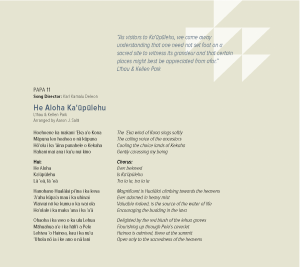
The beautiful song to the left by Kellen and Lihau written for the 2012 Kamehameha Schools Song Contest can be heard at 2012 Songs timeline 02:11:11 to 02:15:35.
Hannah Kihalani Springer is deeply connected to the lands of Ka‘ūpūlehu both by ancestral lineage and personal kuleana. As a founding member of the Dryland Forest Working Group, she toiled the dryland forest lands in the late 1990s when fencing and restoration of the 70-acres of Ho‘ola Ka Makana‘ā began. She gives voice to cultural and geologic history of this ‘āina so that connections not be forgotten. This video is from the 2012 Dryland Forest Symposium in Kona.
Hannah Kihanlani Springer‘s contribution to the 2011 Hawaii Conservation Conference Forum: Ka’upulehu: Our Kuleana, Our Alohacan be seen at this link: https://vimeo.com/44843219
At the following link, you can watch a Kamehameha Schools Bishop Estate video about the cultural landscape and ancestral connections to Hualalai mountain, and the ahupua‘a of Ka‘ūpūlehu, also known as Ka‘ulupūlehu by many elder kama‘āina. See a short video about Ka‘ūpūlehu mauka-makai cultural landscape and ancestral connections at the following link: Ka‘ūpūlehu Cultural Landscape video
The 2014 Dryland Forest Symposium in Kailua-Kona featured two partners to Ka‘ūpūlehu. Watch their presentations here:
- Dr. Alexandra Moore, EES-Cornell on collaborations:
- Ku‘ulei Keakealani on “Preservation of Homeland Connections”:
The 2013 Dryland Forest Symposium talk on “Āina Kaumaha” by Namaka Whitehead also discusses Ka‘ūpūlehu: vimeo.com/62806537
And the following videos from the 2011 Hawai‘i Conservation Conference Forum feature Ka‘ūpūlehu: Forest as ‘Ohana—Culturally-based Forest Restoration in Hawai‘i.
- Yvonne Yarber Carter, Outreach Education & Volunteer Coordinator, Ka‘ūpūlehu
Culturally-based Forest Restoration in Hawai‘i—Forest as ‘ohana. “Aunty Yvonne” believes the hope for the future of our native forests is the guiding principle of kuleana and the saying, “Take care of the land, and it will take care of you.” This approach to restoration entwines: respect, aloha, sharing, diversity, partnerships, cultural legacy, protocols of behavior and forest as family.
https://vimeo.com/44842312 - Keoki Apokolani Carter, Outreach Education & Volunteer Coordinator, Kealakehe
Cultural ecology needs requires patience and respect. “Uncle Keoki” has grown into a relationship with the forest that embraces and entwines his old style rural Hawaiian upbringing and social values with a formal education as a certified teacher, and advanced degree in Wood Science. Striving first to be true to his cultural worldview and commitment to the land, science learning provides an added lens of understanding. Looking at restoration within the time frame of elder trees, he reminds young stewards to the forest that “good things take time”. - Drew Kapp, UH, Hilo and Hawai‘i Community College, Geography & Environmental Studies Dept.
The extended family—efficacy, and sustainability of stewardship learning opportunities and partnerships with restoration sites that value cultural legacy. Working and learning journeys or huaka‘i “represents one of the most valuable components of our courses.” Drew Kapp has done much to expand the extended ‘ohana of volunteers at many restoration projects on Hawai‘i island.
https://vimeo.com/44842809 - Wilds Pihanui Brawner—Site manager, DHHL Kealakehe and Ka‘ūpūlehu Dryland Forest.
Cultural ecology as an approach to site management, and why nurturing a culture of volunteers, training interns and youth is vital to restoration efforts. Internship opportunities helped to prepare Wilds for his present work as a dryland forest site manager.
https://vimeo.com/44842810 - Pua Herron-Whitehead, HYCC Americorps intern.
The importance of learning opportunities in an ‘ohana setting. Perspective of a young steward being trained and employed in a cultural ecology setting, that was made possible by internship funding and programs.
https://vimeo.com/44842811
















